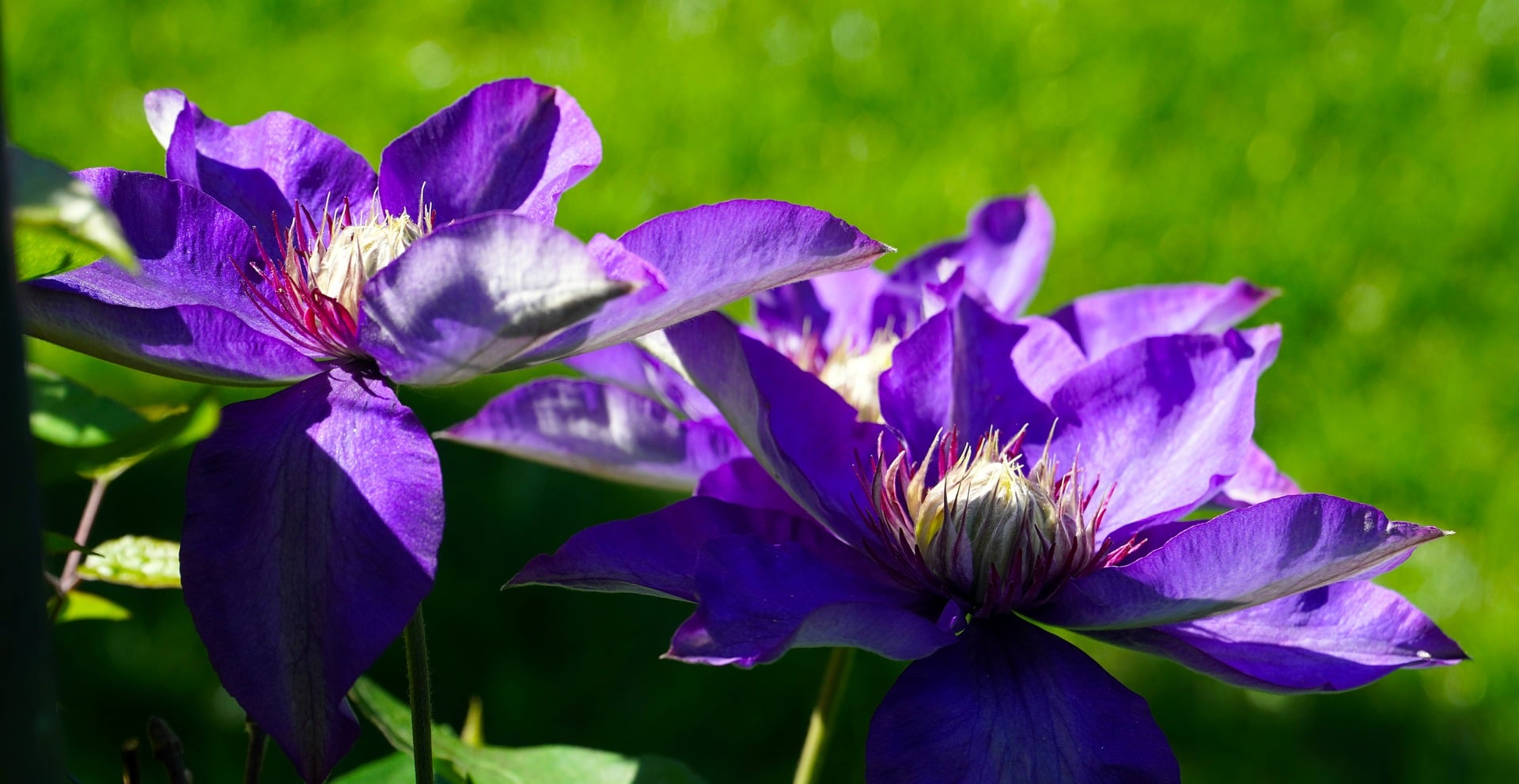There are hundreds of species of Clematis, and finding out what kind you actually have will be a challenge. The main problem with identifying what kind of Clematis you have is that all of them look more or less the same, except for their flowers.
To quickly identify your clematis, focus on observing its flowers, middle of the flowers, and leaves. The size of the flowers is a key factor, with clematis typically falling into two main groups: small-flowered (under 5 inches in diameter) and large-flowered. To aid in identification, refer to photos of common clematis varieties that match the characteristics of your plant.
If you are a fan of Clematis, then my personal recommendation is to grow some Sweet Summer Love Clematis that have Red-Purple flowers, Click here to check it out on Amazon.com
The best time to identify your Clematis is when it is in full bloom, different groups of Clematis have different flowering periods, and based on that you can narrow it down quite a lot. Trying to identify the Clematis during the winter or when it is dormant will be impossible, as almost all Clematis look the same when they are dormant. With the exception of evergreen Clematis as these tend to keep their leaves even during the winter.
One of the main reasons why you should know what kind of Clematis you have is to know how to prune it. Although if you simply can not identify what kind of Clematis you have, then just leave it be and don’t prune it. If you want to know which mulch is the best for Clematis, then check out my recent article Best Mulch For Clematis ( Top 8 Mulches ).
What Kind Of Clematis Do I Have?
Identifying the specific type of clematis you have can be challenging, as there are numerous cultivars and varieties available. However, there are a few key characteristics to consider when determining the type of clematis you have. Start by examining the plant’s growth habit, flower form, and bloom time. Clematis can be categorized into three main groups: Group 1, Group 2, and Group 3, based on their pruning requirements and bloom time.
Group 1 clematis typically bloom on old wood in early spring, Group 2 clematis bloom on both old and new wood in late spring to early summer, and Group 3 clematis bloom on new wood in summer and fall. Additionally, consider the flower shape, color, and size to further narrow down the possibilities.
Earn a 50% Commission on each sale by simply sharing my guides with friends and family on social media, check out Flower Duty Affiliates
Identify The Clematis Based On Blooming Period
As I have previously mentioned, the easiest way of identifying a Clematis is when it is blooming. If your Clematis is not yet flowering then simply wait for it to flower. Clematis are categorized into 3 groups, each of them having different flowering periods. Once you have identified to which group it belongs, all you need to do is to Google what kind of group clematis you have and add the color of the flower.
Group 1 Clematis
Group 1 Clematis are spring flowering, so if your Clematis is flowering in the spring it might belong to this group although it is not 100% guaranteed. The most common Group 1 Clematis are Clematis Alpina, Clematis Armandii, Clematis Cirrhosa and Clematis Japonica.
Group 2 Clematis
Group 2 Clematis are repeat bloomers, so if your Clematis blooms twice a year then it belongs to Group 2. The problem with identifying Group 2 Clematis is that they flower during the spring and late summer or early fall. This means that you will have to wait and see if it actually flowers twice. The most common group 2 Clematis are Clematis Candida, Clematis Multi Blue, Clematis The President, and Clematis Niobe.
Group 3 Clematis
Group 3 Clematis tend to flower at the end of the summer or in the early fall. Group 3 Clematis only bloom once per year, so if your Clematis has bloomed both in the spring and in the fall as well then it is part of Group 2. The most common Group 3 Clematis are Clematis Viticella, Clematis Texensis, Clematis Happy Jack, and Clematis Jackmanii Superba.
Identifying Your Clematis Based On Where The Flowers Are Growing
Clematis will bloom either on old or on new wood, depending on which group it actually belongs to. Group 3 Clematis will bloom on new wood, Group 2 and Group 1 Clematis bloom only on old wood. As I have previously mentioned, once you know the group, simply type into Google the group of Clematis and the color of the flower. If the Clematis is dormant, and you are not sure what kind you have then, do not touch it, allow it to bloom first. If you want to know how to care for Clematis in the winter, then check out my recent article Clematis Winter Care ( In 5 Easy Steps ).
Identifying Your Clematis Based On Where They Are Growing
Some Clematis grow really well in full sun while others do in partial shade. Just keep in mind that most varieties of Clematis will grow in partial shade, but the ones that love full sun will usually have smaller flowers if they are growing in partial shade. The most common full sun loving Clematis are Clematis Pink Mink, Clematis Sweet Autumn, Clematis Jackmanii, and Clematis Pink Fantasy.
The most common partial shade tolerant Clematis are Clematis Alpina, Clematis Montana Elizabeth. Clematis Polish Spirit, and Clematis Nelly Moser.
Identifying Your Clematis Based On The Size Of The Flowers
Clematis either grow large or small flowers, and this can narrow it down to what kind of Clematis you actually have. The main problem with identifying your Clematis based on the size of the flower is that what kind of group the Clematis actually belongs to doesn’t dictate the size of the flowers, meaning that all groups of Clematis tend to have both small and large-flowered ones.
The most common large flwoerd Clematis are Clematis Niobe, Clematis Starburst, Clematis Josephine, and Clematis Nelly Moser. The most common small flwoerd clematis are Clematis Princess Diana, Clematis Super Nova, and Clematis Aromatica. If you want to mulch your Clematis, then check out my recent article Mulching Clematis ( In 4 Easy Steps ).
Identifying The Clematis Based On When It Has Been Pruned
You can easily identify to which group your Clematis belongs based on when it was pruned, but only if it has been pruned correctly. Group 3 Clematis bloom on new wood, which means that these ones are usually pruned fairly hard in the late fall and Group 1 and 2 Clematis are usually lightly pruned in the spring. Although knowing when the Clematis was pruned will not identify the Clematis but it will allow you to know at least to which group it belongs.
This is especially important if you tend to buy your plants in the off season, when they are the cheapest.
Find Out If Your Clematis Is Actually A Clematis
Even though you might have paid good money for your Clematis, it might not actually be one. It is way too easy to mix up plants in nurseries, a simple misplaced label can easily end up on a plant that it doesn’t belong to. There are a lot of apps that identify plants, and all you need to do is to take a picture of the leaf of the plant. Although most of these apps can not identify what kind of Clematis you have, but they can identify if it is a Clematis or not.
Key Takeaways
- To know what kind of Clematis you have, you must allow it to flower. Once you know when it actually flowers it will be easy to find to which group it belongs to. Take a close look if the flowers are growing on old or new wood, and how large the size of the flower is. From there on, all you need to do is search online for the group, specify the size and the color of the flowers and you will know what Clematis you have.
- It will be impossible to identify what kind of Clematis you have based only on the shape of its leaves.
- If you do not know what kind of Clematis you have, then allow it to flower, just keep in mind that if it is a spring blooming one it can be part of Group 1 or 2, so wait until the fall to see if it blooms again or not.

